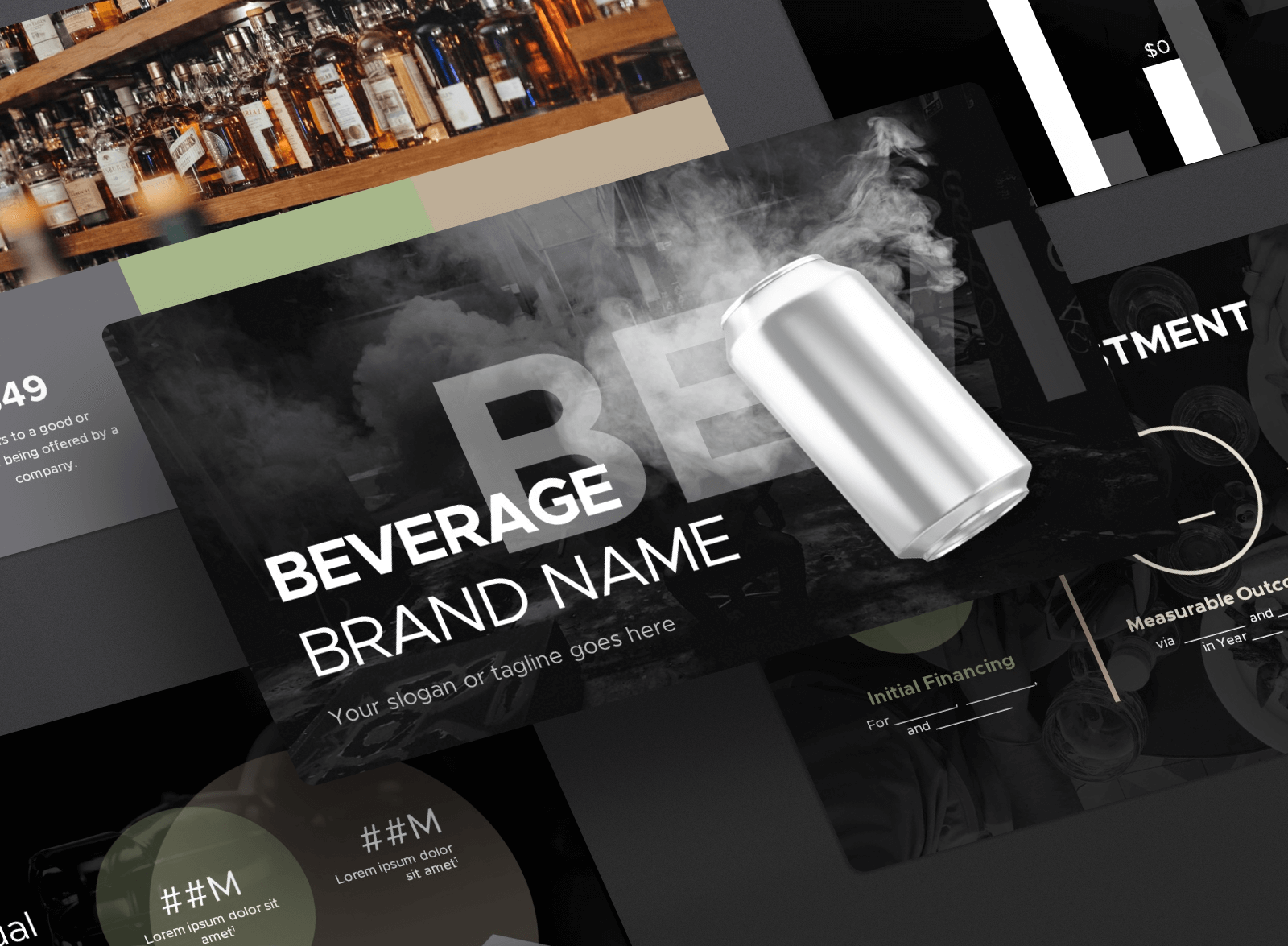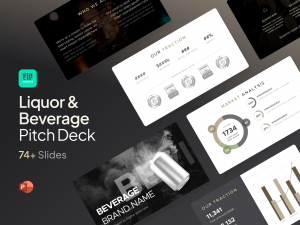The global craft spirits market is experiencing a boom, valued at USD 21.40 billion in 2023 and projected to grow at a staggering 28.4% CAGR by 2030, according to Grand View Research industry reports.
This surge is fueled by a growing consumer demand for premium, unique liquors and a rise in disposable incomes. Yet, despite this explosive growth, securing funding for a new liquor startup can be a daunting task.
This article equips you with the knowledge and strategies needed to craft a winning liquor pitch deck, one that captures investor attention and propels your brand towards success.
What’s a liquor pitch deck?
A liquor pitch deck is a concise document that tells the story of your brand, highlighting its potential for success. Unlike a standard pitch deck, a liquor pitch deck caters specifically to the beverage industry, focusing on market trends, target demographics, and the unique allure of your product.
Investor vs. retail decks: different strokes for different folks
There’s a subtle difference between a deck for investors and one for retailers. While both versions will showcase your brand and its potential, the investor deck delves deeper into financials, projections, and funding needs.
Here’s a breakdown of the key purposes depending on who you’re presenting to:
- Investor Pitch Deck: The primary goal is to secure funding to fuel your business growth. This deck emphasizes the market potential of your liquor, the strength of your business model, and the return on investment (ROI) for potential investors.
- Retail Pitch Deck: The objective here is to convince retailers to stock your liquor on their shelves. This deck focuses on the appeal of your product to its target audience, the potential sales and profit margins, and any marketing or promotional support you can offer.
What slides should be in your alcohol brand’s pitch deck?
Now, let’s dive into the essential parts of a winning liquor pitch deck:
Cover Slide
Your cover slide sets the tone for your entire presentation. Make a strong first impression by featuring your brand logo prominently alongside your tagline. Include a high-quality product image that captures the essence of your liquor. Ensure the image is visually appealing and reflects the brand personality. This could be a close-up shot of the bottle showcasing its design or an image that evokes the experience of enjoying your drink.
Problem & Opportunity
Most liquor startups don’t solve a glaring problem but rather identify a gap in the market. In this slide, pinpoint the unmet consumer needs that your brand addresses. Is it the lack of a specific spirit type, like a high-quality, locally sourced tequila? A desire for liquors made with organic ingredients? A preference for artisanal production methods? Clearly articulate the unmet need and how your brand uniquely fills it.
Solution
This slide is all about telling your brand story. Explain the inspiration behind your liquor, its unique value proposition (UVP), and what sets it apart from competitors. What makes your brand special? Is it a family recipe passed down through generations, infused with a rich history? Or perhaps a focus on sustainability, using eco-friendly packaging and locally sourced ingredients? Here’s your chance to showcase the heart and soul behind your brand and the unique value it brings to the market.
Product Line
Here’s where you get to showcase your product line in all its glory. Include high-quality photos that highlight the design and craftsmanship of your packaging. Consider including close-up shots of the bottle design and label to showcase your brand identity. These visuals should entice investors and leave a lasting impression.
Competitive Advantage
The liquor market is crowded, so it’s crucial to differentiate your brand. Highlight the factors that set your drink apart. Focus on unique ingredients, innovative production methods, awards you’ve won, or distinctive brand storytelling elements. Do you use rare botanicals in your gin recipe? Is your vodka distilled using a unique filtration process? Explain how your competitive advantage translates into a strong market position and allows you to capture consumer attention.
Market Landscape & Opportunity
Don’t just present market size statistics in this slide. It’s about demonstrating why your product is perfectly positioned for success. Leverage current trends within the spirits industry to support your claims. Is there a growing interest in small-batch spirits, organic ingredients, or specific flavor profiles that align perfectly with your offering? Explain how your product caters to these trends and taps into a thriving segment of the market.
Target Audience
Clearly define your ideal customers. Who are you trying to reach with your liquor brand? Outline their demographics (age, income level, location), preferences (flavor profiles, consumption occasions), and buying habits. Understanding your target audience allows you to tailor your marketing and sales strategies for maximum impact. This information demonstrates to investors that you have a clear understanding of your customer base and a well-defined strategy for reaching them.
Traction & Validation
This could include secured distribution deals with retailers or restaurants, impressive customer growth statistics if you’ve launched your product, or key performance indicators (KPIs) like average order value (AOV) and lifetime value (LTV) if you have existing sales data. Include customer reviews, testimonials, and average star ratings to demonstrate positive reception from your target audience.
Roadmap
Outline your plans for the future. This could include new product launches, strategic partnerships with distributors or influencers, or future market expansion plans. Be clear about how these plans will help you achieve your long-term goals.
Team
Introduce your key team members, highlighting their qualifications and experience. Showcase the expertise and passion behind your brand. Investors want to see a dedicated and capable team driving the business forward.
Investment Ask (for Investor Decks)
For investor decks, clearly state your funding needs. Explain how the investment will be used to propel your brand forward. This could include expanding production capabilities, scaling your marketing efforts, or entering new markets.
Vision
Paint a picture of the long-term future of your brand. Explain how you plan to expand your total addressable market (TAM). Do you envision your brand becoming a national or even international player?
Call to Action
End with a clear and compelling call to action. Are you seeking an investment, a distribution partnership, or a retail placement? Make it clear what you want the audience to do next, whether it’s contacting you for further discussion or visiting your website to learn more.
Tips for designing alcohol startup pitch decks
Here are some key tips to ensure your liquor pitch deck packs a punch and leaves a lasting impression:
- Focus on Trends, Not Market Size: The liquor industry is vast, but it’s the specific trends within that market that matter. Explain why your product aligns perfectly with current consumer preferences.
- Quantify Your Success: Back up your claims with solid data and metrics. Use numbers to showcase demand, market potential, and the value proposition of your brand.
- Market First, How-To Later: Investors might not want to know much about the nitty-gritty of production. Focus on the attractive market opportunity and how your brand capitalizes on it.
Ready to craft your winning deck?
Looking to craft a liquor pitch deck that gets investors and retailers raising a glass to your brand? Check out this Liquor Pitch Deck designed by VIP Graphics—packed with winning slides based on decks that have landed millions in funding and secured placements on shelves worldwide. Don’t miss out on this opportunity to impress potential partners and investors. Check it out here.

